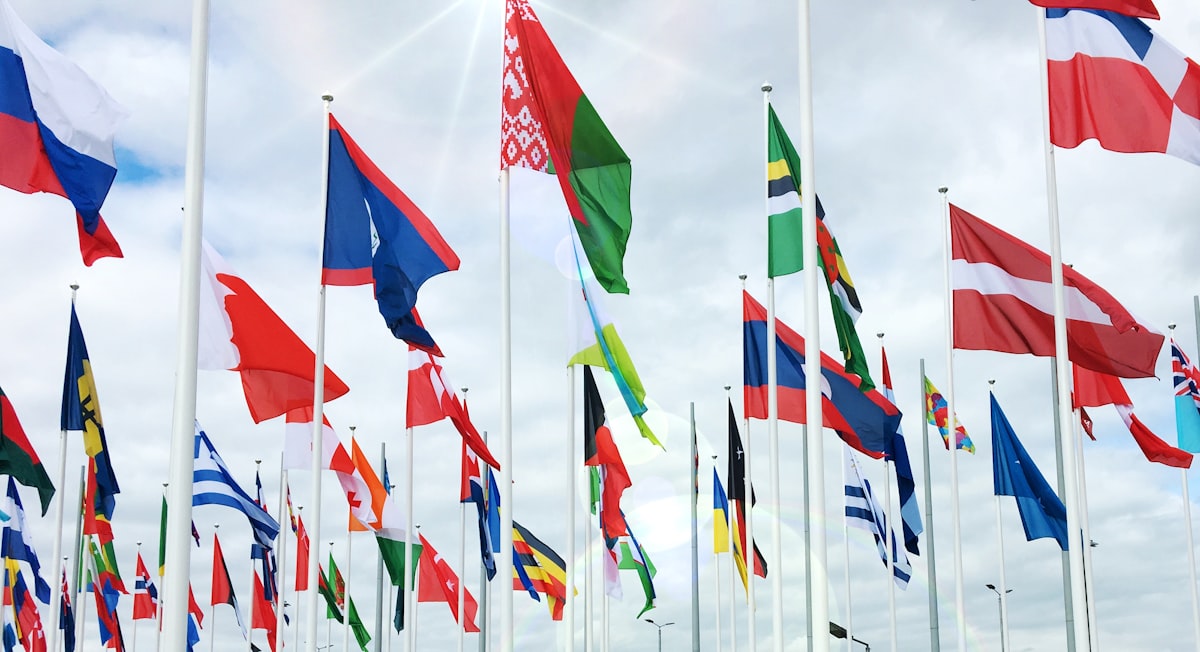Overview
Why is studying cross-cultural communication is important?
- Avoid misunderstandings
Different cultures have different communication styles. This course helps you avoid misunderstandings caused by body language, humor, or even directness in conversation. - Build stronger relationships
By understanding cultural norms, you can interact more effectively with people from different backgrounds, fostering trust and rapport. - Global success
In today's interconnected world, many careers involve working with international clients or colleagues. This course equips you with the skills to navigate these interactions.
Who is this crash course for?
Professionals or anyone just entering the workforce, especially those in fields with international connections or working in diverse teams.
Students preparing for study abroad programs, international careers, or even just navigating a multicultural campus environment.
*This micro course was designed & curated by Jon Santangelo: Contact for answers

I. Introduction
Cross-cultural communication is when people from different cultures talk to each other and share information and ideas. Understanding and respecting cultural differences, being aware of your own cultural biases, and using good communication skills are the basics of cross-cultural communication. This means paying attention to things like body language and facial expressions known as nonverbal communication, and speaking in clear, simple language. It also means being willing to learn about and understand other cultures and being willing to change the way you talk to people to better fit their needs. Cross-cultural communication also requires a lot of active listening and empathy.
Here are five things you should know about communicating across cultures.
Please mark true (T) or false (F) next to each statement.
1. Cross-cultural communication is when people from different cultures share information and ideas with each other. T/F
2. In cross-cultural communication, nonverbal cues like facial expressions and body language are universal and mean the same thing in every culture. T/F
3. When communicating with people from other cultures, it's important not to use idioms and slang, since they may not be understood. T/F
4. For cross-cultural communication to work, people must use the same communication styles as the people they are talking to from another culture. T/F
5. Cross-cultural communication is only needed when talking to people from cultures other than the West. T/F

Section 1: Personal Contexts
II. Cultural Biases
Cultural biases are the beliefs, attitudes, and stereotypes that a person has about a certain culture or group of people, whether they were taught to them or not. These prejudices can affect how a person sees, understands, and treats people from that culture or group, which can lead to discrimination and prejudice. Cultural biases can be both good and bad, depending on things like race, ethnicity, religion, nationality, gender, sexual orientation, socioeconomic status, and so on.
Here are five things you should know about cultural biases when talking to people from other cultures. Please mark true (T) or false (F) next to each statement.
- Cultural biases are attitudes or ideas that people have about a certain culture or group of people that they don't even realize they have. T/F
- Cross-cultural communication is only affected by cultural biases when the person talking is very against the other culture.T/F
- When people from different cultures talk to each other, it can help to avoid misunderstandings if people are aware of their own cultural biases.T/F
- Cultural biases can make it hard to understand and interpret what people from other cultures are trying to say. T/F
- Cultural biases only affect the person who has them; they have no effect on the person who is on the other end of the communication. T/F

III. Nonverbal Communication
Nonverbal communication is the process of sending and receiving messages that don't use words. This can include things like the way someone looks, moves, talks, and sounds.
Here are some examples of nonverbal communication:
- Facial expressions: A smile, a frown, or an eyebrow raised can show a wide range of feelings and attitudes.
- Body language is made up of posture, movements, and gestures that can show things like confidence, anger, or submission.
- Proximity: How far apart people are when they talk can show things like closeness or discomfort.
- Touch: A pat on the back or a handshake can be used to say congratulations, offer comfort, or say thank you.
- Tone of voice: The pitch, volume, and inflection of a person's voice can show how happy, sad, or sarcastic they are.
- Appearance: Clothing, hairstyle, and other physical traits can show things like social status, professionalism, or personal style.
Nonverbal communication is important because it can tell a lot of different things and feelings that might not be possible to say with words alone. This can include things like the way someone looks, moves, talks, and makes gestures. Nonverbal cues can tell us a lot about a person's thoughts, feelings, and plans. They can also be used to support or go against what someone says. Nonverbal communication can also be a big part of building and keeping relationships, as well as showing status and power. Because nonverbal cues can be different from one culture to the next, it's important to be aware of them when communicating across cultures.
Here are five multiple-choice questions about nonverbal communication:
1. What is the main purpose of communicating without words?
a) To show how you feel
b) To share information
c) To make and keep friends
d) All of the above
2. Which of the following is the most likely place to use nonverbal communication?
a) A person giving a speech in front of a big crowd
b) Someone having a private conversation with a close friend
c) Someone typing an email to a coworker
d) Someone listening to a podcast by themselves
3. What is an example of a nonverbal cue?
a) How they look
b) How they sound
c) What they say
d) All of the above
4. Which of these is not an example of a nonverbal cue?
a) Gestures
b) Posture
c) Verbal language
d) Touch
5. How can nonverbal cues be misunderstood when people from different cultures talk to each other?
a) Because some nonverbal cues have different meanings in different cultures.
b) Because nonverbal cues are the same in all cultures.
c) Because nonverbal cues are not important in cross-cultural communication.
d) None of the above

IV. Simple Language
How to talk to people who don't speak your language as their first language in a way that is clear and easy to understand?
When talking to people who don't speak your language as their first language, it's important to use clear, simple language so they can understand you. Here are some suggestions:
- Slow down and be clear: Talk a little bit slower than you would with a native speaker, and make sure to say each word clearly.
- Use simple words and phrases. Don't use complicated or technical terms. Instead, use words and phrases that are common in everyday speech.
- Use hand gestures and visual aids, like pictures or diagrams, to help people understand what you mean.
- Repeat and rephrase: If the person you're talking to seems confused, say what you said again or say it in a different way.
- Ask for feedback. Ask the person if they understand what you said and if they have any questions.
- Avoid idioms and figures of speech. They can be hard for non-native speakers to understand because they don't always mean what they say.
Remember that people who don't speak your language as their first language may need more time to understand and respond to what you say. Be kind and patient with them as they try to talk to you in a new language.
Here are five multiple-choice questions and answers about how to use simple language:
1. What's the best way to talk to someone who doesn't speak your language as their first language?
a) Use difficult words and phrases
b) Speak slowly and clearly
c) Use visual aids like gestures and pictures
d) All of the above
2. How should you talk to people who don't speak your language as their first language?
a) Speak loudly
b) speak quickly
c) speak slowly and clearly
d) speak in a monotone
3. Should you use idioms and other everyday phrases when talking to people who don't speak your first language?
a) Yes, it will show how well you speak the language
b) No, it can be confusing
4. What should you do if you don't understand what someone who doesn't speak your language as their first language is saying?
a) Ask them to say it again
b) Pretend to understand
c) Show that you don't understand or politely ask them to explain
5. How should you handle non-verbal communication with people who don't speak your language as their first language?
a) Don't use gestures
b) Use gestures and facial expressions to help get your point across
c) Speak in a flat, monotone voice

V. Active Listening
Active listening is a way to show that you are interested in a conversation by paying close attention to the speaker, understanding what they are saying, and giving verbal and nonverbal feedback. Active listening means that you don't just hear the words that are said, but you also understand what they mean.
Here's what people who listen well do:
- Listen to the speaker and don't do anything else.
- Don't talk over the speaker.
- To make sure people understand what the speaker has said, rewrite and summarize what he or she has said.
- Try to understand the other person's feelings and point of view.
- Ask questions to make sure you understand anything that isn't clear.
- Give feedback both verbally and nonverbally, such as by nodding, making eye contact, and responding with the right facial expressions.
- Active listening can help people build trust and understanding, improve their relationships, and find solutions to problems. It is also an important skill for communicating well in many different situations, like customer service, counseling, and negotiating in sales.
Here's a multiple choice quiz about active listening:
1. Active listening is a way to communicate that includes:
a) Interrupting the speaker
b) Ignoring the speaker
c) Paying attention to the speaker and getting their message
2. Active listening does NOT include which of the following?
a) Listening to what the speaker is saying
b) giving verbal cues
c) talking more than the speaker
3. To show that you're paying attention, you should:
a) Interrupt the speaker
b) Make direct eye contact
c) Stay away from other things
4. To make sure you understand what the speaker is saying, you should:
a. Repeat what the speaker says in your own words
b. Change the subject
c. Interrupt the speaker
5. Active listening is especially helpful in:
a) hard conversations,
b) sales pitches
c) both a and b

VI. Time
Different cultures can have different ideas about what “time” is. In some cultures, time is seen as fixed and rigid, while in others, it is seen as more fluid and changeable. Understanding how people from different cultures think about time can help avoid misunderstandings and improve cross-cultural communication.
Here are a few ways in which culture can change how people think about time:
- Monochronic vs. polychronic: Some cultures, like those in the US and Northern Europe, tend to see time as a series of separate and distinct events (monochronic) and prefer to focus on one task at a time, while others, like those in Latin America and Africa, tend to see time as more flexible and overlapping (polychronic) and may put more importance on multiple tasks or relationships at the same time.
- Punctuality is important in some cultures, and being late is seen as rude in those cultures. In other cultures, time may not be as important, and people may not care as much about being on time.
- Long-term vs. short-term focus: Some cultures tend to focus on the long term, like planning for the future, while others tend to focus on the present moment and immediate concerns.
- Directness in communication: Some cultures may talk about time and schedules more directly and to the point, while others may be more indirect and use more subtle cues to say what they mean.
How much do you know about countries now? Here is a multiple choice quiz about how the concept of time affects cultural behaviors in different countries. Try your best to answer!
1. In which culture is punctuality (arriving on time) considered very important?
a) American
b) Japanese
c) Mexican
2. In which culture is a more relaxed attitude towards time common?
a) Indian
b) German
c) Chinese
3. In which culture is the concept of "face-to-face time" important?
a) Dutch
b) French
c) American
4. In which culture is it considered rude to be early for an appointment?
a) Mediterranean
b) African
c) South East Asian
5. Which culture values long-term planning and goal-setting?
a) American
b) Chinese
c) Brazilian

VII. Touch
How affection and physical touch are seen and shown can vary a lot from one culture to the next. Understanding these differences can help people from different cultures get along better and avoid misunderstandings.
Here are a few ways in which culture can change how people see affection and physical contact:
Physical touch: Some cultures, like those in Latin America, the Middle East, and some Asian countries, tend to use more physical touch in their interactions, like hugging and kissing on the cheek, while others, like those in Anglo-Saxon cultures, tend to use less physical touch and may see it as more personal or reserved for close relationships.
Personal space: When it comes to personal space, different cultures have different rules. Some cultures value physical distance more, while others value being close.
Displays of affection in public vs. in private: Some cultures accept or even expect public displays of affection, while others see them as more private or even wrong.
Gender differences: In some cultures, men are expected to show less affection and body contact than women.
Touch in professional settings: Some cultures see touch as a friendly and positive part of professional interactions, while others see it as more personal and not appropriate in professional settings.
Again, these are generalizations. Cultures are complicated, and there may be differences between them. It's important to keep an open mind and be aware of different ways to show affection and touch in different cultures.
Here is a true or false quiz and multiple choice quiz about the concept of touch in cross-cultural communication:
True or False:
- In some cultures, physical touch is considered a sign of respect and intimacy.
- In some cultures, direct eye contact is considered rude.
- In some cultures, it is considered impolite to touch someone's head.
- In some cultures, it is considered rude to touch someone on the arm during a conversation.
- In some cultures, it is considered appropriate to stand very close to someone when speaking with them.
Multiple Choice:
- In some cultures, physical touch is considered
a) Respectful
b) Rude
c) Neutral - In some cultures, it is considered appropriate to touch someone during a conversation
a) Only on the arm
b) Only on the back
c) Anywhere - In some cultures, it is considered impolite to touch someone's
a) Head
b) Feet
c) Shoulders - In some cultures, it is considered appropriate to stand
a) Very close
b) Far away
c) No preference - In some cultures, direct eye contact is considered
a) Rude
b) Respectful
c) No preference

Section 2: Cultural Contexts
VIII. Economics
Understanding a country's economy can help you understand how people act in that country because economic factors can have a big effect on the values, beliefs, and norms of a society. For example, a country with a strong economy might put a lot of value on hard work and success, while a country with a weaker economy might put more value on community and working together. Also, economic factors like unemployment and income inequality can change how people feel about social issues and how well they feel in general.
The economy can also affect cultural behaviors that have to do with buying things, like fashion, leisure activities, and travel. For example, people in a country with a high GDP per capita are likely to be able to afford luxury goods and experiences, while people in a country with a low GDP per capita may be more focused on the things they need.
Economic factors can also affect how people act in ways that affect their ability to move up in society, such as their education and career choices. For instance, people in a country with a high GDP per capita are more likely to have access to higher education and jobs, while people in a country with a low GDP per capita may be more interested in the informal economy.
Overall, knowing how a country's economy works can help you understand how people act in that country's culture. This is because you'll have a better idea of how the economy affects people's values, beliefs, and norms, as well as how it affects consumption, social mobility, social issues, and the overall well-being of its citizens.
Here are two quizzes about how economics affect cross-cultural communication:
True or False:
- Consumption-related cultural behaviors, such as fashion and leisure activities, can be changed by the economy. (T/F)
- People's sense of well-being and how they feel about social issues can be affected by things like unemployment and income inequality. (T/F)
- The economy doesn't change how people talk to each other. (T/F)
- Understanding a country's economy can help you understand how people act there. (T/F)
- Economic factors can affect how people act in ways that affect their ability to move up in society, such as their education and career choices. (T/F)
6. Economic conditions can affect:
a) how people spend their money
b) how they move up in society
c) both a and b
7. Economic factors like unemployment and income inequality can change:
a) how people feel about social issues;
b) How happy people feel
c) Both a and b
8. Understanding a country's economy can give you clues about:
a) its cultural norms
b) its political views
c) both a and b
9. Economic factors can influence cultural behaviors related to:
a) Social mobility
b) Religious beliefs
c) Both a and b
10. The economy doesn't necessarily change the way people:
a) Communicate
b) Consume or buy things
c) Both a) and b)

IX. Idioms
Common phrases and idioms can tell you a lot about a country's culture because they often reflect the values, beliefs, and habits of a society. They can also tell you about the history, customs, and popular culture of the area.
For instance, sayings and idioms about food and eating can tell a lot about how important food is in a culture. In some cultures, food is seen as a sign of friendliness and generosity. In others, it may be seen as a sign of plenty or lack.
Family- and relationship-related phrases and idioms can also tell a lot about how a culture sees itself. In some cultures, family is seen as the most important thing in life, while in others, being an individual is highly valued.
Work- and productivity-related idioms and phrases can tell a lot about a culture's work ethic and values. For example, idioms about hard work and determination may show how important these traits are in a culture.
Also, idioms and phrases can show how a country's history, geography, and environment have shaped it. For example, idioms about the sea or fishing may show a country's history along the coast, and idioms about the weather may show how the country's climate affects its people.
In general, learning the common phrases and idioms of a country can help you learn more about its values, beliefs, customs, traditions, history, and environment.
Test your knowldge on understanding idioms. Here is a multiple choice quiz about how local idioms can influence cultural communication:
- Idioms can reveal a lot about a culture's:
a) Values and beliefs
b) Customs and traditions
c) All of the above - The idioms "to have a green thumb" or "to have a way with plants" is an example of idioms that reflect a culture's:
a) Agricultural or farming heritage
b) Urban or city heritage
c) Industrial heritage - The idioms "to be a night owl" or "to be a morning person" is an example of idioms that reflect a culture's:
a) Work ethic
b) Social norms, normal social behaviors
c) Both a and b - The idioms "to have a chip on one's shoulder" or "to have a bone to pick" is an example of idioms that reflect a culture's:
a) Solving personal conflicts
b) Attitudes towards authority, the police or goverment
c) Both a and b - The idioms "to be a big fish in a small pond" or "to be a small fish in a big pond" is an example of idioms that reflect a culture's:
a) Social hierarchy
b) Attitudes towards competition in school or work
c) Both a and b

X. Food
Local food and cuisine can affect how people from different cultures talk to each other. Food is a big part of every culture, and the way people eat, what they eat, and the social events that happen around food can all tell you a lot about their beliefs, values, and customs.
For example, the way food is cooked, served, and eaten can tell a lot about the social norms and etiquette of a culture. In some cultures, it might be rude to start eating before everyone is seated and served. In other cultures, it might be more casual and easygoing.
Food can also show a lot about the history and geography of a culture. For instance, a country's traditional dishes may show its agricultural roots or how other cultures have influenced its food.
Food is another way that people show who they are and can also be used to share cultural values. In some cultures, food is a way to show hospitality and generosity, while in others, it can be used to show who is in charge and how important they are.
Also, food and cuisine can be a way to communicate and connect with people from other cultures, helping to break down barriers and build understanding. For example, sharing a meal with someone from a different culture can be a good way to get to know them and learn about their culture.
Local food and cuisine can help people from different cultures communicate with each other by showing what their values, beliefs, customs, history, geography, and identity are. It can also be a way to meet people from other cultures and talk to them.
Here is a true or false, and multiple choice quiz about how local food influences cross cultural communication
- Eating local foods can help break down cultural barriers and foster cross-cultural communication. True or False?
- In some cultures, sharing a meal is seen as a way to build relationships and establish trust. True or False?
- Local foods are always better for the environment than imported foods. True or False?
- Local foods are always more nutritious than imported foods. True or False?
- Which of the following is a potential benefit of eating local foods?
a) Supporting the local economy and first-hand cultural experience
b) Reducing carbon emissions from transportation
c) Improving public health
d) All of the above - In which cultures is sharing a meal considered a way to build relationships?
a) Japanese
b) Chinese
c) Both a and b
d) None of the above - Which of the following is a potential drawback of eating local foods?
a) Limited variety
b) Higher prices
c) Less convenient
d) All of the above - How eating local food can help in cross cultural communication?
a) Eating local food can help break down cultural barriers and support cross-cultural communication
b) Eating local food can be a way to show respect and understanding of the local culture
c) Eating local food can be a way to bond and share common experiences with people from different cultures
d) All of the above

XI. Fashion
In many ways, fashion can affect how people from different cultures talk to each other. Here are just a few:
Fashion can be used to show a person's cultural background and help people understand and respect each other's cultures. Clothing, hairstyles, and accessories can all be used to show that someone is part of a certain group or culture.
Fashion can be used to show personality and style, which can help people from different cultures communicate and understand each other better. People often use their clothes and accessories to show off who they are and connect with people from other cultures.
Fashion can be used to show social status and wealth, which can make it hard to communicate with people from other cultures. High-end fashion items can show that a person is wealthy or comes from a high-status background, which can affect how people interact with or think about them.
Culture can change and become more diverse, and fashion can show that. As fashion styles and trends change over time, they can show how attitudes or values in a culture are changing. They can also help people understand how different cultures are.
Politics and social movements can be communicated through fashion, which can also affect how people from different cultures talk to each other. Clothing, hairstyles, and accessories can be used to send political or social messages, like showing support for a certain cause or group.
Fashion can help people understand and relate to each other's backgrounds, cultures, and experiences, which is an important part of cross-cultural communication.
Here's a quiz about how fashion can affect how people from different cultures talk to each other
1. What is one way that culture can be shown through clothing?
a) Showing individuality and personal style
b) Showing social status and wealth
c) Clothing, accessories, and hairstyles
d) Communicating political and social movements
2. How can fashion help people from different cultures talk to each other and understand each other better?
a) By showing individuality and style
b) By showing social status and wealth
c): By showing cultural identity
d) By letting people know about political and social movements
3. How do clothes, accessories, and hairstyles help people learn about and appreciate each other's cultures?
a) By showing individuality and style
b) By showing social status and wealth
c) By showing cultural identity
d) By letting people know about political and social movements
4. How high-end fashion can affect how people from different cultures talk to each other?
a) By showing individuality and style
b) By showing social status and wealth
c) By showing cultural identity
d) By letting people know about political and social movements
5. Styles and trends in fashion can help people understand how different cultures by?
a) Showing individuality and style
b) Showing social status and wealth
c) Showing cultural identity
d) Showing cultural change and diversity

XII. History
The history of a country can affect how people there act and how they talk to people from other cultures in many ways. Here are just a few:
Cultural attitudes and values can be changed by what happened in the past. This can change how people from one culture see and treat people from other cultures. For instance, a country that has been at war or been colonized may have a culture that values peace and independence, and people from that country may be less likely to act aggressively or cause trouble with people from other cultures.
The way people from one culture interact with people from other cultures can be affected by how their customs and traditions were formed. For example, a country with a history of religious persecution may have a culture that values religious freedom and is more likely to respect and tolerate the religious beliefs of people from other cultures.
Historical events can shape cultural identities, which can change how people from one culture see and define themselves in relation to people from other cultures. For example, a country with a long history of immigration may have a culture that values multiculturalism and diversity and is more likely to accept and celebrate the cultural heritage of people from other cultures.
Cultural behaviors can be changed by what happened in the past, which can change how people from one culture interact with people from other cultures. For example, a country with a history of political oppression may have a culture that values civic engagement and may be more likely to take part in cross-cultural activities and projects.
People from a culture's history also shape how they see the world and other cultures. This can affect how they talk to and interact with people from other cultures. For example, a country with a history of economic hardship may have a culture that values resourcefulness and self-sufficiency and may be less likely to depend on people from other cultures for help or support.
A country's history can have a big effect on how people in that country act and how they talk to people from other cultures. It can shape attitudes, customs, identities, and behaviors that can affect how people from different cultures talk to each other and understand each other.
Test your knowledge. Here's a quiz about how a country's history affects how its people act:
1. How did Japan's history of feudalism change the way people act?
A. It led to a strong focus on tradition, hierarchy, and respecting the people in charge.
B. It led to a strong focus on being your own person and expressing yourself.
C. It didn't make a big difference in how people behaved.
2. How did the history of the Industrial Revolution change the way people in Great Britain lived their lives?
A. It led to a big focus on hard work, being efficient, and getting things done.
B. It made people pay a lot of attention to leisure, pleasure, and hedonism.
C. It didn't make a big difference in how people behaved.
3. How did the history of the French Revolution change the way people in France lived their lives?
A. It made people pay a lot of attention to democracy, equality, and people's rights.
B. It led to a strong focus on tradition, hierarchy, and respecting the people in charge.
C. It didn't make a big difference in how people behaved.
True or False?
4. The history of imperialism had a big impact on how people in Africa lived their lives, despite Africa’s continent being so large and diverse. (True/False)
5. The history of the Roman Empire didn't have a big impact on how people in Western Europe live their lives today, since it was so long ago. (True/False)
6. The history of the Cultural Revolution had a big impact on how people in China live their lives now. (True/False)
7. The history of the Vikings had a big impact on how people in Iceland live now. (True/False)
8. The history of the Renaissance had a big impact on how people in Italy lived their lives, despite it being centuries ago. (True/False)

XIII. Arts
A country's arts and media scene can affect how its people act by influencing communication styles. Arts and media can also change the way people talk to each other by showing them examples of different ways to express themselves.
The arts of a country can affect the way its people communicate in several ways:
Literature, poetry, and other forms of written art can have an effect on how people use language and choose words. For example, a country with a long history of telling stories may value the use of descriptive language and metaphors when talking. Another example, a culture that values eloquence and the use of metaphors in communication might come from a country with a long history of poetry or literature.
Nonverbal communication: Theater, dance, and mime can all have an effect on how people use nonverbal communication. For example, a country with a long history of physical theater might value the use of gestures and facial expressions when talking.
Emotion and expression: Arts like music, painting, and sculpture can change how people show how they feel and what they want to say. For example, a country that has a long history of sad music may have a culture that values showing how you feel when you talk.
Cultural references: Arts like movies, TV, and comic books can affect how people talk to each other by giving them shared cultural references. For example, a country like the United States, has a long history of movies which may have a culture that values referring to popular movies when talking.
Storytelling: Arts like literature, poetry, and storytelling can change how people talk to each other by showing them different ways to tell stories. For example, a culture may value storytelling as a way to communicate if it has a long history of telling stories orally.
Here's a quiz about how the arts of a country can affect how its people communicate:
1. How might the way people talk change in a country where telling stories is a big part of culture?
A. People may talk more about what they mean and use more metaphors.
B. People may talk to each other with more technical terms and jargon.
C. People may talk less when they talk to each other.
2. How might the use of nonverbal communication change in a country with a long history of physical theater?
A. People may use more body language and facial expressions to talk.
B. People may use less body language when they talk to each other.
C. People may talk to each other more through written language.
3. How might the way people talk about their feelings change in a country where emotional music is a big part of the culture?
A. People may be able to talk about their feelings more freely and openly.
B. People may talk less about their feelings when they talk to each other.
C. People may be more reserved and formal in how they talk about their feelings.
4. How might the use of popular movie references change in a country with a long history of making movies?
A. People might talk about movies more when they want to connect with each other.
B. People may talk less about movies when they talk to each other.
C. People may talk to each other more through written language.
5. How could storytelling be used to get a message across in a country where telling stories is a big deal?
A. Storytelling could be used more often and in more situations as a way to share meaning and connect with others.
B. Telling stories may not be used as much in communication.
C. Storytelling can be used in a more formal way to get a message across.

END OF COURSE, PART 1
